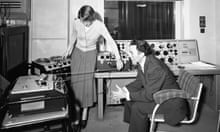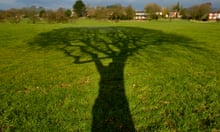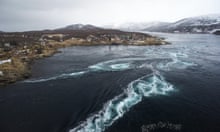High up on a mountain plateau in Lapland there has been a tense silence for some days. A crew from the Norwegian Broadcasting Corporation (NRK) has been stuck with a herd of reindeer that shows no sign of moving. But move they must. Food is getting scarce and, besides, their annual spring migration, towards new grazing land down at the coast 200 km away, is live on TV. Every minute of it.
The transmission started on Monday night, but, as the reindeer scraped through snow searching for more food, the lead female deer looked on, unconcerned and immobile. The crew, less so. “We were waiting for the lead female to make a move,” editor Ole Rune Hætta explains. All reindeer herds have female leaders, but this one seemed to be a little stuck. More than 1,000 reindeer and many more television viewers – including those across the world following the livestream – were about to go on a spectacular journey, if she ever got going.
No wonder this programme, Reinflytting: Minutt for Minutt, has been nicknamed “the impossible project” by the crew. “It was conceived over a cup of coffee somewhere at an NRK district office some three years ago,” Hætta says, adding that nobody wants to take responsibility for it right now, as there are so many things that can go wrong.

First of all, the areas are so remote they are not covered by communications satellites. Alternative options had to be devised. After months of preparations, the crew came up with mirrors to reflect signals along the route. Drones will also be employed, as well as a camera operator named Muzet, meaning “black” in Sami language. He’s a male reindeer who has been being tamed since December, and will wear camera gear on his head. Hopefully, he will behave.
The herd will make its way from Šuoššjávri to Kvaløya across far northern Norway, for what is expected to be between six and nine days. Reindeer rest every six hours, taking naps for between one and three hours. Live TV will last for seven days, but, should the journey be unfinished at that point, it will continue to be streamed online. Either way, the audience won’t miss the herd’s impressive swim across the strait of Kvaløya.

Reindeer herding has been happening for hundreds of years without anybody but the Sami people noticing. “The aim of the project is to make a completely unknown part of Norwegian daily life known to the rest of the Norwegians,” Hætta explains.
Reinflytting: Minutt for Minutt is the 11th Norwegian slow-TV project. Little did NRK know what a success their 2009 live production of the train journey from Oslo to Bergen would be – people stayed in front of the television for seven hours straight. Further shows featured yarn being knitted and logs being chopped and then burned. Språkrådet, Norway’s national council on language, named “sakte-tv” (slow TV) the new word of the year in 2013. The trend caught on in the UK, too – 1 million people tuned into the BBC’s All Aboard!, which featured two hours of footage from a bus travelling around the Yorkshire Dales.
Their success is seen as a reaction to our stressed daily lives. “Slow TV gives us an unique experience, the feeling of being present in real time and space, and I do not think this is a specifically Norwegian phenomenon,” says Rune Møklebust, head of programming at NRK Hordaland. “Norwegians are not really slow … it’s more like a coincidence that it happened here in the first place. Give anyone a story they really care about and they will pay attention.”
Back on the plateau, the reindeer are finally under way (you can follow their progress on the show’s interactive map), although it looks as if the team have picked some of the most sluggish reindeer in Norway – resulting in some truly slow TV.









Comments (…)
Sign in or create your Guardian account to join the discussion